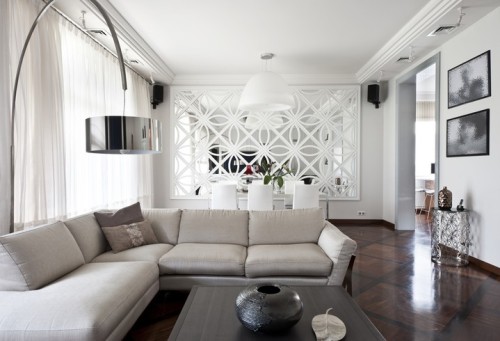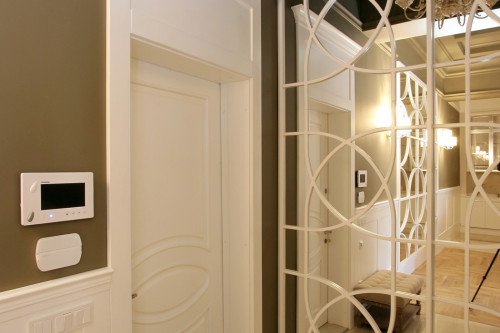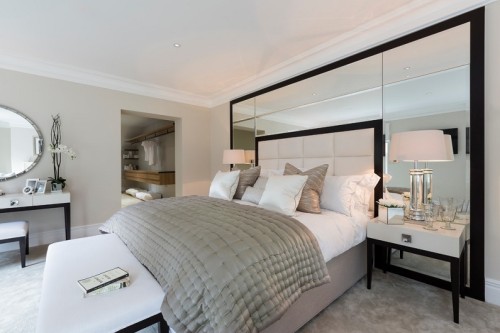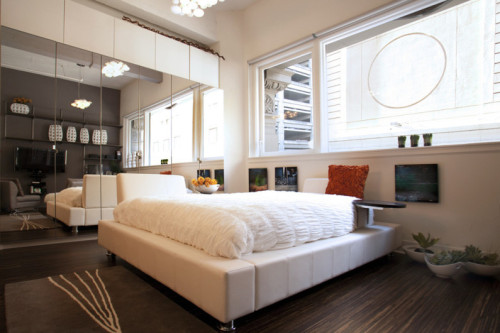What only finishing materials will not meet in the modern construction market. The variety of means for facing the walls and the ceiling is striking the imagination, but a fashionable and up-to-date version remains a mirror design. Reflective surfaces fit perfectly into any style and design of the room, can be used in residential buildings, offices, shops, restaurants and other buildings of the most detailed destination. Fortunately, now it has become much easier to perform such a finish, because modern mirror panels have excellent performance and easy to work.
Content
Description of the material and the features of its use
Mirrors are often used not only with decorative, but also with a practical purpose, since they are able to visually expand the space and reflect light well. Even small point lamps of low power will be quite enough to light the room decorated with mirrors.
The mirror panels were widely used not only in apartments and homes, but also in the halls of shopping centers, in offices, shops, studios and various public facilities. As for residential areas, the panel with a reflective surface can most often meet in the bathrooms, bedrooms, hallways and shower. Some also prefer such a finish in the kitchen interior. Especially successful in this design will look a kitchen of small dimensions, in which there is too little natural lighting.
If you decide to bind the room with mirror wall panels, remember that care for such a finish will have to be carefully. Any, even the smallest, contamination on the reflective surface will be very noticeable, especially for cases when the panels are installed in the kitchen or in the hallway. But the mirror surfaces are easily mounted from any stains with ordinary means for washing the glasses.
As for the use of mirror panels in non-residential premises, it can be noted that such a finish is often found in nightclubs, restaurants, cafes, shops, sports halls, dance studios, as well as in boutiques for the sale of clothing and shoes. In the latter case, the mirrors not only visually expand the space of the store, but also create the impression of a huge range of goods presented on sale.
The process of finishing walls with mirror panels should be performed very carefully, because the slightest errors in the installation or improper preparation of the base will ultimately spoil all the beauty of the facing. Even the slightest curvature of the walls or inconsistencies of individual elements will be very noticeable. If you do not have sufficient experience of such work, it is better not to risk and trusting masters that will do everything perfectly. In addition, if not plastic panels with reflective film are used for cladding, and the glass mirrors, the incorrect installation may cause injuries.
Mirror panels for walls: advantages and types of material
Previously, ordinary glass mirrors were most often used in the mirror finish of the interiors, but later it became clear that such elements are rather fragile, require special caution during the installation process, they have a lot of weight and in certain cases can threaten health. In modern finishing, the panels of polyvinyl chloride are most often used, the front side of which is covered with a thin film with a reflective surface. This film is additionally revealed by transparent varnish, which makes it even more durable and shiny. Of the advantages of such a facing material, such characteristics can be distinguished:
- Mirror plastic panels repel water, protecting the surface of the walls from dampness and mold. Such decoration can be used anywhere, including in rooms with high humidity, such as in the bathrooms. Plastic does not deteriorate and does not deform even with long-term contact with water.
- Unlike ordinary mirrors, plastic decorative panels are considered shockproof. They cannot be broken down into fragments, and with very strong mechanical exposure it can only be left on the surface a small dent.
- PVC panels do not react with many chemicals, including acids and alkalis. Such decoration can be cleaned using any detergents having a liquid or gel consistency. Such means should also not contain chlorine in its composition.
- Working with plastic panels is much easier than with real mirrors. PVC is perfectly cut, dried, sawing and bends.
- Since polyvinyl chloride refers to plastic materials, it can be given the most unthinkable forms, which you can not say about the glass. Thus, not only smooth and even elements can be present in the decorative decoration of the room, but also curved parts.
- Plastic panels can be fastened with each other by heating with a construction hairdryer, they also glued well with special adhesive compositions.
- Plastic panels, although not made from natural ingredients, are considered safe for health and do not bear the threat of environmental pollution.
- Since there are no pores on the smooth reflecting surface of such a finishing material, pathogenic organisms and fungi will not be multiplied on the walls.
On the construction market there are several types of decorative panels:
- The mirror panels on a self-adhesive basis are separate parts of plastic, the front side of which is covered with a reflective film of silver, golden or other shade. On the reverse side, as a rule, a finished glue layer is provided. When installing such a material additionally use glue no need.
- Panels without a glue layer - a similar finishing material that does not have adhesive surface on one of its sides. Such panels are mounted on the wall using polyvinyl acetate based compounds, are installed on brackets or screws.
- Mirror self-adhesive panels made in the form of a roll material. They are also equipped with a finished adhesive layer and are suitable for finishing various surfaces.
- Polyvinyl chloride mirrored film is the material used mainly in the ceiling decoration. It is tensioned on the previously created frame and forms a smooth, smooth, very beautiful reflective surface with almost no flaws.
Facing the walls with mirror panels
Useful recommendations
There are several ways to attach mirror parts to the work surface, but regardless of the selected method, you need to know some rules for working with such material:
- The amalgam on the mirrors should be rack and high-quality, especially if you are going to use the material in the kitchen or bathroom finish. The poor-quality amalgam under the action of dampness quickly creases, and the coating will lose its beautiful view.
- Some mirror surfaces have increasing properties - this feature must be taken into account at the material selection phase. Not in any interior, an approaching mirror will look at the place, but some designs it, on the contrary, will decorate.
- Since the mirror visually expands the space, it is important to choose the right wall correctly, which will be lined with such material.
- Flowers of mirror panels There are also quite a lot, the choice is not limited to golden and silver options.
- Choosing a facing material, you need to carefully produce all the calculations and determine the size of the panels, as well as with the most appropriate installation method.
Methods of installation of decorative panels
When mounting on the wall of the mirror panels it is important to understand that the work is painstaking and requires great accuracy. Every detail must be docked on the other so that the canvas turned out to be solid and smooth, and the reflection was not distorted. It is also necessary to carefully prepare the basis, since the Wall curve can also cause the deterioration of the final result. The methods of fastening the material on the wall there are several, for example, the parts can be fixed on the surface using a bracket or brackets. In such cases, a small gap is provided between the finishing material and the wall, which provides ventilation and does not give the wall to be mold from excessive accumulation of moisture. When installing mirrors on the brackets, the probability of getting distortion is pretty small, moreover, if necessary, any item can easily dismantle and replace.
If for any reason the brackets cannot be mounted, the mirrors can be fixed with screws or glue. In the case of screws in the panels, you will have to drill holes, and if you glue the panels directly to the wall, it will be quite difficult to remove them if necessary.
Let's look at the features of each of the ways to install mirror panels on the wall:
- If you make a facing with the help of a bracket, first do not make a marker wall in the form of horizontal lines spent in places where the top and bottom of the panels will be alleged. Using a building level, carefully check the horizontal lines. On each of the two lines, put marks corresponding to the width of individual mirror parts. Since the mirrors will feel tightly to each other, there should be no gaps between the marks. In the upper and at the bottom parts of the walls, install fasteners so that their edges coincide with the horizontal lines. Fix the fasteners using screws. The distance between the brackets should be the same. Initially, the lower unregulated fasteners should be installed, and then the upper, adjustable. Before installing panels, each of them should be processed along the internal perimeter with special mastic. Applying such a substance in 4 layers, you will get an additional spring protection. When it is done, the panel can be inserted into fasteners. To do this, take one item for the edges and insert it into the lower bracket, slightly tilting over yourself. Then gently and slowly press the mirror to the wall until the layer of mastic is about 5 mm. When this happens, the top of the panel will enter the top fastener, which can be omitted.
- Installation of panels with screws involves drilling holes in the details of the facing material. As in the first case, first need to be placed the wall. Each panel makes holes through which screws will be screwed. Then the part is applied to the wall and through the drilled holes on the working surface put points. In the marked places in the wall plug dowels. Complete with self-drawing for mirror panels, soft gaskets are sold, which prevent the severity of the finishing material. These gaskets are inserted between the screw of the self-press and the mirror surface directly. Behind the self-tapping screw washed the washer. After that, the panel is lifted by the edges and insert it into a dowel, and then spin the screws sufficiently tight enough to fix the mirror on the wall. Self-tapping screws need gradually and very carefully.
- Installation of mirrors on adhesive mastic is produced using a special substance that is intended specifically for such purposes. The mastic is soft enough and never freezes completely, so in the case of needing the mirror can be removed without much difficulty. The adhesive material does not include substances that damaging the reflecting layer, besides, the springing properties of mastic protect the panels from damage in case of strong shocks and shocks. Mastics are applied to the entire surface of the finishing material, leaving only small indents on the edges. The width of these indents should be approximately 6 cm. Covering the panel with mastic, they are pressed against the wall and dock together. In this case, it is also desirable to place the wall in advance, so that individual details lay on the surface exactly and did not form gaps. If the panels cover the entire surface of the walls, small departments from the floor and the ceiling should be provided, since in these places, vibrations are periodically affected on the wall.
Mirror panels, photo:



























